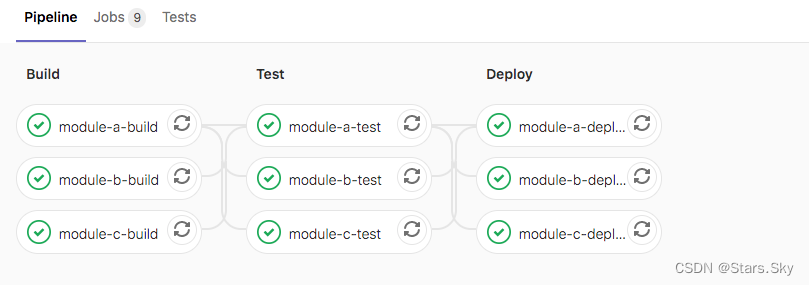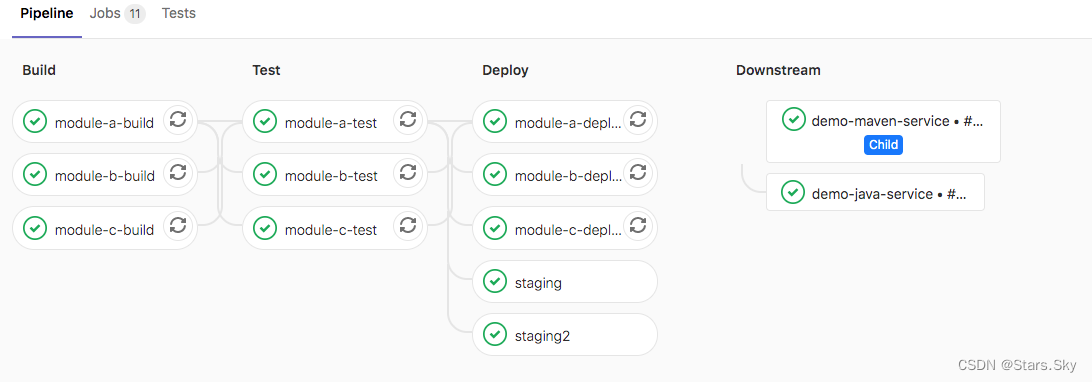目录
needs 并行阶段
可无序执行作业,无需按照阶段顺序运行某些作业,可以让多个阶段同时运行。
stages:
- build
- test
- deploy
module-a-build:
stage: build
script:
- echo "hello3a"
- sleep 10
module-b-build:
stage: build
script:
- echo "hello3b"
- sleep 10
module-a-test:
stage: test
script:
- echo "hello3a"
- sleep 10
needs: ["module-a-build"]
module-b-test:
stage: test
script:
- echo "hello3b"
- sleep 10
needs: ["module-b-build"]
如果 needs:设置为指向因 only/except 规则而未实例化的作业,或者不存在,则创建管道时会出现 YAML 错误。
暂时限制了作业在 needs:可能需要的最大作业数分配,ci_dag_limit_needs 功能标志已启用(默认)分配 10 个,如果功能被禁用为 50。
Feature::disable(:ci_dag_limit_needs) # 50
Feature::enable(:ci_dag_limit_needs) # 10制品下载
在使用 needs,可通过 artifacts: true 或 artifacts: false 来控制工件下载。 默认不指定为 true。
module-a-test:
stage: test
script:
- echo "hello3a"
- sleep 10
needs:
- job: "module-a-build"
artifacts: true 相同项目中的管道制品下载,通过将 project 关键字设置为当前项目的名称,并指定引用,可以使用 needs 从当前项目的不同管道中下载工件。在下面的示例中,build_job 将使用other-ref ref 下载最新成功的 build-1 作业的工件:
build_job:
stage: build
script:
- ls -lhR
needs:
- project: group/same-project-name
job: build-1
ref: other-ref
artifacts: true不支持从 parallel: 运行的作业中下载工件。
include
可以允许引入外部 YAML 文件,文件具有扩展名 .yml 或 .yaml。使用合并功能可以自定义和覆盖包含本地定义的 CI / CD 配置。相同的 job 会合并,参数值以源文件为准。
local 引入本地配置
引入同一存储库中的文件,使用相对于根目录的完整路径进行引用,与配置文件在同一分支上使用。
ci/localci.yml: 定义一个作业用于发布。
stages:
- deploy
deployjob:
stage: deploy
script:
- echo 'deploy'.gitlab-ci.yml 引入本地的 CI 文件 'ci/localci.yml'。
include:
local: 'ci/localci.yml'
stages:
- build
- test
- deploy
buildjob:
stage: build
script: ls
testjob:
stage: test
script: ls
file 引入其他项目配置
包含来自另一个项目的文件。
include:
- project: demo/demo-java-service
ref: master
file: '.gitlab-ci.yml'template 引入官方配置
只能使用官方提供的模板:lib/gitlab/ci/templates · master · GitLab.org / GitLab · GitLab
include:
- template: Auto-DevOps.gitlab-ci.ymlremote 引入远程配置
用于通过 HTTP / HTTPS 包含来自其他位置的文件,并使用完整 URL 进行引用。远程文件必须可以通过简单的 GET 请求公开访问,因为不支持远程 URL 中的身份验证架构。
include:
- remote: 'https://gitlab.com/awesome-project/raw/master/.gitlab-ci-template.yml'extends 继承作业配置
继承模板作业。
stages:
- test
variables:
RSPEC: 'test'
.tests:
script: echo "mvn test"
stage: test
only:
refs:
- branches
testjob:
extends: .tests
script: echo "mvn clean test"
only:
variables:
- $RSPEC合并后:
testjob:
stage: test
script: mvn clean test
only:
variables:
- $RSPEC
refs:
- branchesextends & include
这将运行名为 useTemplate 的作业,该作业运行 echo Hello! 如 .template 作业中所定义,并使用本地作业中所定义的 alpine Docker 镜像。
定义一个 aa.yml:
deployjob:
stage: deploy
script:
- echo 'deploy'
only:
- dev
.template:
stage: build
script:
- echo "build"
only:
- masterinclude:
local: 'ci/localci.yml'
stages:
- test
- build
- deploy
variables:
RSPEC: 'test'
.tests:
script: echo "mvn test"
stage: test
only:
refs:
- branches
testjob:
extends: .tests
script: echo "mvn clean test"
only:
variables:
- $RSPEC
newbuildjob:
script:
- echo "123"
extends: .templatetrigger 管道触发
当 GitLab 从 trigger 定义创建的作业启动时,将创建一个下游管道。允许创建多项目管道和子管道。将 trigger 与 when:manual 一起使用会导致错误。
多项目管道:跨多个项目设置流水线,以便一个项目中的管道可以触发另一个项目中的管道。[微服务架构]
父子管道:在同一项目中管道可以触发一组同时运行的子管道,子管道仍然按照阶段顺序执行其每个作业,但是可以自由地继续执行各个阶段,而不必等待父管道中无关的作业完成。
多项目管道
当前面阶段运行完成后,触发 demo/demo-java-service 项目 master 流水线。创建上游管道的用户需要具有对下游项目的访问权限。如果发现下游项目用户没有访问权限以在其中创建管道,则 staging 作业将被标记为失败。
staging:
variables:
ENVIRONMENT: staging
stage: deploy
trigger:
project: demo/demo-java-service
branch: master
strategy: depend project 关键字,用于指定下游项目的完整路径。该 branch 关键字指定由指定的项目分支的名称。使用 variables 关键字将变量传递到下游管道。 全局变量也会传递给下游项目。上游管道优先于下游管道。如果在上游和下游项目中定义了两个具有相同名称的变量,则在上游项目中定义的变量将优先。默认情况下,一旦创建下游管道,trigger 作业就会以 success 状态完成。strategy: depend 将自身状态从触发的管道合并到源作业。
 在下游项目中查看管道信息:
在下游项目中查看管道信息:
 在此示例中,一旦创建了下游管道,该
在此示例中,一旦创建了下游管道,该 staging 将被标记为成功。
父子管道
创建子管道 ci/child01.yml:
stages:
- build
child-a-build:
stage: build
script:
- echo "hello3a"
- sleep 10在父管道触发子管道:
staging2:
variables:
ENVIRONMENT: staging
stage: deploy
trigger:
include: ci/child01.yml
strategy: depend
image
准备环境
这次我们在学习语法时候需要准备一个注册 docker 执行器类型的 runner。可以参考以下命令指定:(根据实际情况修改)
sudo gitlab-runner register \
--non-interactive \
--url "http://192.168.170.133/" \
--registration-token "GR1348941sUxNyye1qD4HcTSW-TMw" \
--executor "docker" \
--docker-image alpine:latest \
--description "docker-runner" \
--maintenance-note "Free-form maintainer notes about this runner" \
--tag-list "docker,aws" \
--run-untagged="true" \
--locked="false" \
--access-level="not_protected"修改 docker-runner 拉取策略:
[root@run01 /home/gitlab-runner]# vim /etc/gitlab-runner/config.toml
······
[[runners]]
name = "docker-runner"
url = "http://192.168.170.133/"
id = 3
token = "F9JvXdw6AW4zoNsxRGaD"
token_obtained_at = 2023-07-19T07:06:45Z
token_expires_at = 0001-01-01T00:00:00Z
executor = "docker"
[runners.custom_build_dir]
[runners.cache]
[runners.cache.s3]
[runners.cache.gcs]
[runners.cache.azure]
[runners.docker]
pull_policy = "if-not-present" # 增加这一行即可
tls_verify = false
image = "alpine:latest"
privileged = false
disable_entrypoint_overwrite = false
oom_kill_disable = false
disable_cache = false
volumes = ["/cache"]
shm_size = 0
最后在 GitLab-Runner 机器上安装 Docker:【云原生 | Docker 基础篇】02、CentOS 7 安装 Docker 详细图文教程_centos7安装docker_Stars.Sky的博客-CSDN博客 image 语法:默认在注册 runner 的时候需要填写一个基础的镜像,请记住一点只要使用执行器为 docker 类型的 runner 所有的操作运行都会在容器中运行。 如果全局指定了 images 则所有作业使用此 image 创建容器并在其中运行。全局未指定 image,再次查看 job 中是否有指定,如果有此 job 按照指定镜像创建容器并运行,没有则使用注册 runner 时指定的默认镜像。
#image: maven:3.6.3-jdk-8
before_script:
- ls
build:
image: maven:3.6.3-jdk-8
stage: build
tags:
- docker
script:
- ls
- sleep 2
- echo "mvn clean "
- sleep 10
deploy:
stage: deploy
tags:
- docker
script:
- echo "deploy"services
工作期间运行的另一个 Docker 映像,并 link 到 image 关键字定义的 Docker 映像。这样,您就可以在构建期间访问服务映像.
服务映像可以运行任何应用程序,但是最常见的用例是运行数据库容器,例如 mysql 。与每次安装项目时都安装 mysql 相比,使用现有映像并将其作为附加容器运行更容易,更快捷。
services:
- name: mysql:latest
alias: mysql-1environment
声明所部署的环境名称和访问地址,后续可以直接在 gitlab 环境变量中查看。非常方便。
deploy to production:
stage: deploy
script: git push production HEAD:master
environment:
name: production
url: https://prod.example.cominherit
使用或禁用全局定义的环境变量(variables)或默认值(default)。
使用 true、false 决定是否使用,默认为 true
inherit:
default: false
variables: false继承其中的一部分变量或默认值使用 list
inherit:
default:
- parameter1
- parameter2
variables:
- VARIABLE1
- VARIABLE2上一篇文章:【基于 GitLab 的 CI/CD 实践】04、GitLab Pipeline 实践(中)_Stars.Sky的博客-CSDN博客